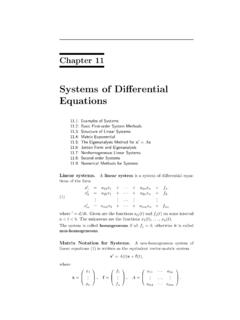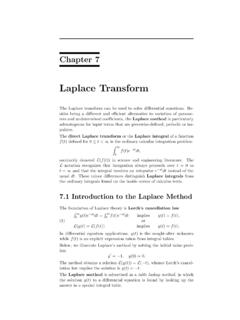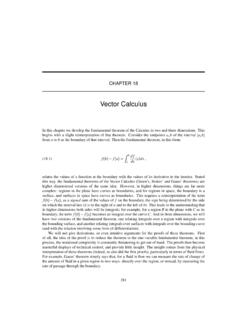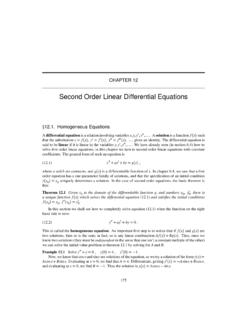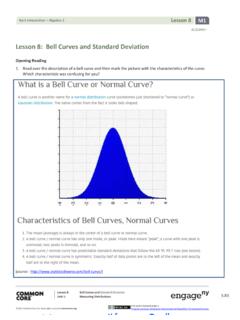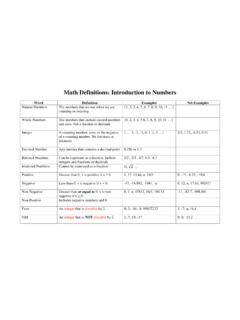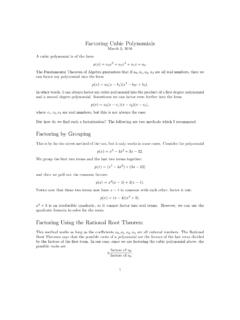Transcription of Rational Functions - Math
1 Rational FunctionsIn this chapter, you ll learn what a Rational function is, and you ll learnhow to sketch the graph of a Rational functionsArational functionis a fraction of polynomials. That is, ifp(x)andq(x)are polynomials, thenp(x)q(x)is a Rational function. Thenumeratorisp(x)andthedenominatorisq(x ).Examples. 3(x 5)(x 1) 1x 2x31=2x3 The last example is both a polynomial and a Rational function. In a similarway, any polynomial is a Rational this class, from this point on, most of the Rational Functions that we ll seewill have both their numerators and their denominators completely will also only see examples where the numerator and the denominatorhave no common factors.
2 (If they did have a common factor, we could justcancel them.)**Implied domainsThe implied domain of a Rational function is the set of all real numbersexceptfor the roots of the denominator. That s because it doesn t makesense to divide by implied domain of 7(x 2)(x2+1)8(x 4)(x 6)is the setR {4,6}.Vertical asymptotesTo graph a Rational function, begin by marking every number on thex-axisthat is a root of the denominator. (The denominator might not have anyroots.)Draw a vertical dashed line through these points. These vertical lines arecalledvertical asymptotes. The graph of the Rational function will climb up or slide down the sides of a vertical the Rational function1x, 0 is the only root of the denominator,so they-axis is the vertical asymptote.
3 Notice that the graph of1xclimbs upthe right side of they-axis and slides down the left side of Rational function 7(x 2)(x2+1)8(x 4)(x 6)has vertical asymptotes atx=4andatx=6.** implied domain of 7(x 2)(x2+1)8(x 4)(x 6)is the setR {4,6}.Vertical asymptotesTo graph a Rational function, begin by marking every number on thex-axisthat is a root of the denominator. (The denominator might not have anyroots.)Draw a vertical dashed line through these points. These vertical lines arecalledvertical asymptotes. The graph of the Rational function will climb up or slide down the sides of a vertical the Rational function1x, 0 is the only root of the denominator,so they-axis is the vertical asymptote.
4 Notice that the graph of1xclimbs upthe right side of they-axis and slides down the left side of Rational function 7(x 2)(x2+1)8(x 4)(x 6)has vertical asymptotes atx=4andatx=6.**152x-interceptsThex-inte rcepts of a Rational functionp(x)q(x)(if there are any) are the numbers 2 Rwherep( )q( )=0If is such a number, then we can multiply byq( )tofindthatp( )=0 q( )=0In other words , is a root ofp(x). Thus, the roots of the numerator areexactly of the Rational function 7(x 2)(x2+1)8(x 4)(x 6)**In betweenx-intercepts and vertical asymptotesWhen graphing a Rational polynomial, first mark the vertical asymptotesand thex-intercepts. Then choose a numberc2 Rbetween any consecutivepairs of these marked points on thex-axis and see if the Rational function ispositive or negative whenx=c.
5 If it s positive, draw a dot above thex-axiswhose first coordinate isc. If it s negative, draw a dot below thex-axis whosefirst coordinate s look at the functionr(x)= 7(x 2)(x2+1)8(x 4)(x 6)again. Thex-intercept of its graph is atx=2andithasverticalasymptotesatx=4andx = 6. We need to decide whetherr(x)ispositiveornegativebetween 2 and 4 on thex-axis, and between 4 and 6 on s start by choosing a number between 2 and 4, say 3. Thenr(3) = 7(3 2)(32+1)8(3 4)(3 6)199 Notice that 7, (3 4), and (3 6) are negative, while 8, (3 2), and (32+1)are you are multiplying and dividing a collection of numbers that aren t equalto 0, just count how many negative numbers there are.
6 If there is an evennumber of negatives, the result will be positive. If there is an odd number ofnegatives, the result will be negative. In the previous paragraph, there arethree negative numbers 7, (3 4), and (3 6) sor(3)< number 5 is a number that is in between 4 and 6, andr(5) = 7(5 2)(32+1)8(5 4)(5 6)>0**Far right and far leftLetaxnbe the leading term ofp(x)andletbxmbe the leading term ofq(x).Recall that far to the right and left,p(x)lookslikeitsleadingterm, far to the right and left,q(x) looks like its leading term,bxm. It followsthat the far right and left portion of the graph of,p(x)q(x)looks likeaxnbxmand this is a function that we know how to leading term of 7(x 2)(x2+1)is 7x3, and the leadingterm of 8(x 4)(x 6) is 8x2.
7 Therefore, the graph ofr(x)= 7(x 2)(x2+1)8(x 4)(x 6)looks like the graph of 7x38x2= 78xon the far left and far right part of its **Putting the graph togetherTo graph a Rational functionp(x)q(x)mark its vertical asymptotes (if any). Mark itsx-intercepts (if any). Deter-mine whether the function is positive or negative in betweenx-intercepts andvertical (x)withitsleadingterm,replaceq(x)withits leadingterm,andthen graph the resulting fraction of leading terms to the right and left ofeverything you ve drawn so far in your draw a reasonable looking graph that fits with everything you ve drawnso far, remembering that the graph has to climb up or slide down the sidesof vertical asymptotes, and that the graph can only touch thex-axis at thex-intercepts that you already s graphr(x)= 7(x 2)(x2+1)8(x 4)(x 6)
8 First we mark its its vertical asymptotes, which are atx=4andx=6,and itsx-intercept, which is atx= **Putting the graph togetherTo graph a Rational functionp(x)q(x)mark its vertical asymptotes (if any). Mark itsx-intercepts (if any). Deter-mine whether the function is positive or negative in betweenx-intercepts andvertical (x)withitsleadingterm,replaceq(x)withits leadingterm,andthen graph the resulting fraction of leading terms to the right and left ofeverything you ve drawn so far in your draw a reasonable looking graph that fits with everything you ve drawnso far, remembering that the graph has to climb up or slide down the sidesof vertical asymptotes, and that the graph can only touch thex-axis at thex-intercepts that you already s graphr(x)= 7(x 2)(x2+1)8(x 4)(x 6)
9 First we mark its its vertical asymptotes, which are atx=4andx=6,and itsx-intercept, which is atx= we plot points that represent what we had checked earlier for whathappens in between consecutive pairs ofx-intercepts and vertical asymptotes:thatr(3)<0andr(5)> the left and right of what we ve graphed so far, we draw the graph of we plot points that represent what we had checked earlier for whathappens in between consecutive pairs ofx-intercepts and vertical asymptotes:thatr(3)<0andr(5)> the left and right of what we ve graphed so far, we draw the graph of we plot points that represent what we had checked earlier for whathappens in between consecutive pairs ofx-intercepts and vertical asymptotes:thatr(3)<0andr(5)> the left and right of what we ve graphed so far, we draw the graph of 0 IIIINow we connect what we ve drawn so far, making sure our graph climbs upor slides down the vertical asymptotes, and that it only touches thex-axis atthe previously labelledx-intercept.
10 **203 Now we connect what we ve drawn so far, making sure our graph climbs upor slides down the vertical asymptotes, and that it only touches thex-axis atthe previously labelledx-intercept.**157 IIaI rfr)ExercisesFor #1-3, use that 4x2 4=4(x 1)(x+1),x3 3x2+4 = (x+1)(x 2)2,and 2x 4=2(x 2) to match each of the three numbered Rational functionson the left with its simplified lettered form on the )4x2 4x3 3x2+4A.)12(x+1)(x 2)2.)x3 3x2+42x 4B.)4(x 1)(x 2)23.)2x 44x2 4C.)(x 2)2(x 1)(x+1)Graph the Rational Functions given in #4-10. (Their numerators and de-nominators have been completely factored.) Then match each graph withone of the lettered graphs drawn on the next two )3(x2+1)(x2+5)8.


